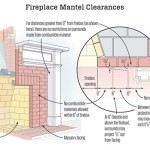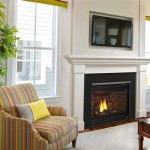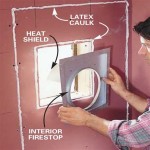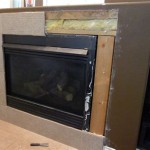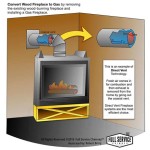```html
DIY Stone Fireplace: Enhancing Your Outdoor Space
An outdoor stone fireplace transforms any backyard into a cozy and inviting entertainment area. Whether you envision intimate evenings under the stars or lively gatherings with friends and family, a DIY stone fireplace offers both aesthetic appeal and practical functionality. While the project requires careful planning and physical effort, the satisfaction of building a custom feature that enhances your outdoor living space is a rewarding experience. This article will provide a comprehensive guide to constructing your own outdoor stone fireplace, covering essential considerations from planning and material selection to construction techniques.
Planning and Design Considerations
Before acquiring any materials or initiating construction, meticulously planning the fireplace design is paramount. Several factors should influence the design process, including the intended location, size, style, and functionality of the fireplace. Proper planning ensures the project aligns with both aesthetic preferences and practical needs.
Location: The placement of the fireplace is a critical decision. Consider prevailing wind direction to minimize smoke affecting seating areas or neighbors. Ensure the area is away from flammable structures, such as fences, sheds, or overhanging trees. Check local regulations and homeowner association guidelines regarding outdoor fireplace construction, setback requirements, and permissible fuel types. Accessibility for material delivery and construction equipment is also essential.
Size and Style: The dimensions of the fireplace should complement the size of the surrounding outdoor space. A disproportionately large fireplace may overwhelm a smaller yard, while a small fireplace might appear insignificant in a sprawling landscape. Consider the architectural style of your home and choose a fireplace design that harmonizes with it. Options range from rustic, natural stone fireplaces to more contemporary designs with clean lines and manufactured stone veneers. The style of your outdoor furniture and landscaping should also inform the design choices.
Functionality: Determine the primary purpose of the fireplace. If it is intended primarily for ambiance, a smaller firebox may suffice. If you plan to use it for cooking, a larger firebox with adjustable grates and integrated cooking surfaces may be necessary. Consider incorporating features such as wood storage niches, seating areas, or decorative elements to enhance the functionality and visual appeal of the fireplace.
Drafting a Plan: Once you have considered the above factors, create a detailed plan. This plan should include precise measurements, material lists, and construction diagrams. A well-defined plan serves as a roadmap for the project, minimizing errors and ensuring a smoother construction process. Consider using design software or consulting with a landscape architect to create professional-grade plans.
Material Selection and Preparation
The choice of materials significantly impacts the aesthetic appeal, durability, and longevity of the outdoor stone fireplace. Selecting the right type of stone, mortar, and other essential components is crucial for a successful project.
Stone Selection: Natural stone offers a unique and timeless aesthetic. Options include fieldstone, flagstone, river rock, and limestone, each with distinct characteristics in terms of color, texture, and shape. Manufactured stone veneer provides a more consistent appearance and is often lighter and easier to install than natural stone. Consider the climate in your region when selecting stone. Certain types of stone are more resistant to weathering and freeze-thaw cycles than others. Ensure that the stone is non-combustible and suitable for use in high-temperature environments.
Mortar Selection: Mortar is the binding agent that holds the stones together. Type S mortar is typically recommended for outdoor stone construction due to its high strength and resistance to weathering. Pre-mixed mortar is convenient for small projects, while dry mortar mixes offer greater control over the consistency and color. Consider adding a mortar colorant to achieve a desired aesthetic effect. Ensure that the mortar is compatible with the type of stone you have selected.
Firebox Materials: The firebox, the area where the fire burns, requires heat-resistant materials. Firebrick is the most common choice for lining the firebox due to its ability to withstand high temperatures without cracking or deteriorating. Firebrick is available in various sizes and shapes, ensuring compatibility with different firebox designs. Refractory mortar, specifically designed for firebrick, should be used to bond the firebricks together.
Other Materials: In addition to stone, mortar, and firebrick, other essential materials include gravel for the foundation, concrete for the footing, rebar for reinforcement, and flue liners for the chimney. Select high-quality flue liners that are appropriately sized for the firebox. Consider purchasing a metal firebox insert to simplify the construction process and improve the fireplace's efficiency. Gather all necessary tools, including a concrete mixer, masonry saw, chisels, hammers, levels, and safety equipment.
Construction Techniques and Safety Precautions
Constructing an outdoor stone fireplace requires a systematic approach, adhering to proper construction techniques and prioritizing safety throughout the process.
Foundation and Footing: Begin by excavating the area for the foundation. Ensure that the foundation extends below the frost line in your region to prevent shifting and cracking due to freezing temperatures. Pour a gravel base for drainage and compact it thoroughly. Construct a concrete footing, reinforced with rebar, to provide a stable base for the fireplace. Allow the concrete to cure completely before proceeding with the stone construction.
Stone Laying: Begin laying the stones, starting with the base of the fireplace. Apply mortar to the back of each stone and press it firmly into place. Use a level to ensure that each stone is level and plumb. Stagger the joints between the stones to create a strong and visually appealing bond. Dry-stack the stones initially to determine the best arrangement and minimize cutting. Use a masonry saw to cut stones as needed to achieve the desired fit and shape. Clean excess mortar from the stone surfaces as you work.
Firebox Construction: Once the foundation and base are complete, construct the firebox using firebrick and refractory mortar. Ensure that the firebox is properly sized to accommodate the intended fuel and provide adequate airflow. Slope the back wall of the firebox slightly inward to improve draft. Install a metal firebox insert, if desired, following the manufacturer's instructions.
Chimney Construction: The chimney is essential for directing smoke away from the seating area. Continue laying stones, incorporating flue liners as you build the chimney. Ensure that the flue liners are properly aligned and sealed to prevent smoke leakage. The chimney should extend above the roofline or any nearby obstructions to ensure adequate draft. Install a chimney cap to prevent rain and debris from entering the chimney.
Safety Precautions: Safety should be paramount throughout the construction process. Wear safety glasses, gloves, and a dust mask to protect yourself from flying debris and dust. Use appropriate lifting techniques to avoid back injuries. Operate power tools safely, following the manufacturer's instructions. Ensure that the construction site is adequately ventilated to prevent the accumulation of hazardous fumes. Have a fire extinguisher readily available in case of accidental spills or fires.
Curing and Finishing: After completing the stone fireplace, allow the mortar to cure fully before lighting a fire. This may take several days or weeks, depending on the type of mortar used and the weather conditions. Clean the stone surfaces with a mild detergent and water to remove any remaining mortar residue. Apply a sealant to the stone surfaces to protect them from weathering and staining. Inspect the fireplace regularly for cracks or damage and make any necessary repairs promptly.
By following these guidelines and taking necessary precautions, homeowners can successfully build a stunning and functional outdoor stone fireplace that enhances their outdoor living space for years to come. The project requires patience, diligence and adherence to building best practices.
```
How To Build An Outdoor Stacked Stone Fireplace

How To Build An Outdoor Fireplace Today S Creative Life

How To Build An Outdoor Fireplace Step By Guide Buildwithroman

Stonetutorials Living Stone Masonry

Stonetutorials Living Stone Masonry

How To Build Outdoor Fireplace Hallstrom Home

Your Diy Outdoor Fireplace Headquarters Plans And Kits By Backyard Flare Llc Tucson Arizona

Diy Outdoor Fireplace Kit Fremont Makes Hardscaping And Easy

How To Build An Outdoor Fireplace Today S Creative Life

Diy Outdoor Stone Fireplace Jc Huffman


